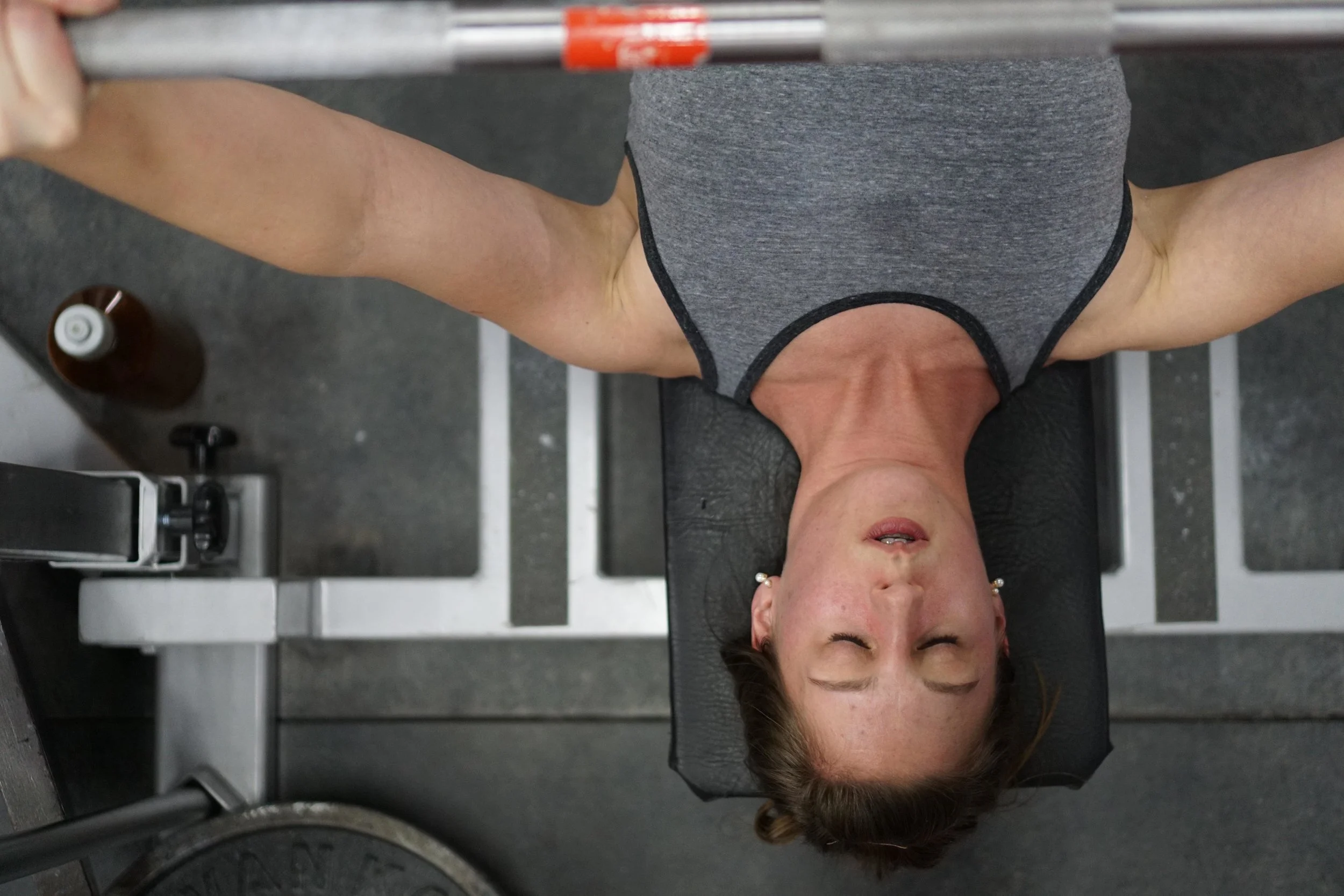The importance of external cues
If you want to change or improve your powerlifting technique for the squat, bench press, and deadlift, there are no shortage of places to look. Every great lifter and coach has a range of cues they believe will do a lifter service to improve the lifts. Ideally, these result from an accurate appraisal of the lifter’s present technique, possibly some biomechanical analysis, a sound background in knowledge of the lifts and available research, and then an accurate cue. Today we’re going to discuss some background research on cues and see that there’s a huge difference in the effectiveness in different types of cues that should allow you to be a better lifter or coach. That’s what it’s all about anyway, right?
What is a cue, really? In our sport, we need to delineate between “change of position” and “cue”. Changes of position usually mean moving a barbell up or down the back, moving the feet in or out, changes in toe angle, in contact point, and so on. These are gross motor refinements with improved bar path as their goal or a change in muscular force profiles for the three lifts. A low bar squat may recruit more of the erectors than a high bar squat, and so on. A suggestion of this kind may have been the result of watching some training footage, or an assessment of relative motor recruitment and strength and weaknesses.
CUES:
Feel your feet
Flare your elbow out once the bar leaves the chest
Push your knees out as you come out of the hole in the squat
Chest up
Head up
Pull the bar into you
Press the bench away from you
Squeeze your butt
Etc.
A cue on the other hand can be better described as a request to shift focus of attention (see the box on the right for some examples). You’re asked to pay attention to a specific idea, or body part, or direction of force, or imaginary scenario, and so on.
The predominant view in the literature used to be that the whole role of feedback in giving cues to an athlete was to make them more aware of their body and how their body is moving through space in a required skill. If someone isn’t swinging a tennis racket correctly, you need to make them more aware of their hand, their arm, their feet, and how to time these all together. This was assumed to be especially important for beginning stages of learning. Called the guidance hypothesis, the idea is that athletes can be overwhelmed with feedback and not learn to develop automaticity on their own if feedback is given too regularly.[i] At the same time, feedback from a coach was assumed to be essential in “guid[ing] the learner to the correct response, thus reducing errors and facilitating performance.”[ii] Later research would show this previous theory to be only partially correct.
We now know that attentional focus can come in two large flavors: internal focus, where the learner is asked to position their awareness on some part of their body, and external focus, where the learner is asked to be aware of their relation with the environment, with no reference to the body itself. Internal cues use references like “hips back”, “chest up”, “focus on squeezing your quads.” External cues instead reference things outside the body, such as “press the bar through the ceiling” or “press into the floor”—there is no reference to the body.
The difference in the use and effectiveness of these cues is vast, and research bears out that external cues are far superior. The current theory is that internal cues, by causing the learner to focus so closely on the body, actually restrict maximal learning by inducing “micro-choke” events where muscles fire in larger amount and not in the correct sequence. Essentially there is less automaticity as a result of focusing so closely on how you’re moving. This makes perfect sense—keeping awareness on the muscles or limbs causes you to activate them more, which actually prevents your body’s own natural process of skill acquisition in a fluid motion by stifling it. Gabriele Wulf described it in 2006 as a promoting of automatic learning instead of directions that “constrain the motor system and disrupt automatic control processes”[iii]
The research on the benefit of using external attentional focus has increased in the last 15 years. In powerlifting especially, the pervading attitude is still one that more focus on the body is better, while the research bears the exact opposite. Here is a summary of key points drawn directly from research.
External attentional focus:
Increased skill learning and skill retention in beginner and advanced golf & volleyball players[iii]
Increased balance in world-class acrobats compared to internal cues[iv]
Increased peak net joint torque in bicep curls (with lower EMG activity, more on that later)[v]
Increased time to failure in a wall sit, and decreased subjective RPE[vi]
Increased agility “L” run times in undergraduate students[vii]
Increased standing long jump distances in in undergraduate students[viii]
And on and on…
Worse, the internal focus groups often did not perform better than control. In other words, an internal cue was often as good as no cue at all. This is to say that everything that is true of external cues above showed a negative effect for internal cues. Athletes still learned the skill and performed at a certain level, but external cues were significantly better.
What’s going on here? It seemed when flipping through this research that cueing an athlete externally enhanced learning speed, skill retention, was better in end-goal oriented tasks and even strength-based tasks. Perhaps the most applicable to powerlifting, Marchant et al. even showed that in intermediate athletes performing the bench press, “an external focus of attention resulted in significantly greater repetitions [with 75% 1RM] completed before failure”.[ix] That’s freaking awesome! They tested the squat and found the same conclusion.
The proposed mechanisms are twofold: one, that external focus distracts us from fussing over the details of something our body is capable of doing on its own, essentially interfering with a good thing. Next, that we’re actually increasing efficiency by focusing attention externally and away from the body. This is referenced by those lower EMG readings above—essentially that athletes are doing more from an outcome and goal-oriented perspective but using less muscle activation to make it happen…they’re moving more efficiently! Its clear that sometimes in practice focusing internally is distracting.
This was shown in dart throwers as well. One of the most interesting things to me was that these dart throwers actually had more movement variation in the shoulder than the group instructed with internal cues. Wait, more movement variation and at the same time, better accuracy, learning, and skill retention? The external groups are learning a movement pattern and adopting individual cases to fit that pattern and maximizing the outcome, instead of focusing on where their wrist is, or how hard to fire their triceps. They learned a global pattern and were able to better apply it in individual cases instead of focusing so internally. I’ve noticed myself that I tend to perform worse (reps move slower, higher chance of failure) when I’m thinking about exactly how I’m moving instead of using this beautiful automatic pattern I’ve built.
Push through the floor
Eyes straight ahead
Pull up to the ceiling
Press the bench away from you
Feel like a robot
Let’s bring it back to practice. By focusing attention outside the body, we see better overall performance and better movement than focusing internally. As coaches and athletes, we should aim to create cues that focus attention externally. What are those cues specifically? This just dictates a range of cues and some general guidelines. There are some suggestions to the right. Try not to reference the body or focus on the squeezing of a muscle, the position of a limb, or the action of body parts in coordination with each other. Even if that’s the outcome you want, phrase it in a more general way, referencing something externally. This actually might give cause to use implements to push against or resistance to feel instead of direction attention inward. And when you hear someone at a meet shout “Hips! Knees! Chest up!” you would do well to ignore it.
[i] Salmoni, A. W., Schmidt, R. A., & Walter, C. B. (1984). Knowledge of results and motor learning: A review and critical appraisal. Psychological Bulletin, 95, 355-386
[ii] Wulf, G., McConnel, N., Gärtner, M., and Schwarz,A. (2002). Enhancing the learning of sport skills through external-focus feedback. J. Mot. Behav. 24, 171-182.
[iii] Wulf, G., and Su, J. (2007). External focus of attention enhances golf shot accuracy in beginners and experts. Res. Q. Exerc. Sport 78, 384-389
[iv] Wulf, G. (2008). Attentional focus effects in balance acrobats. Res. Quart. For Exerc. & Sport, 79, 319-325.
[v] Marchant, D., Greig, M., & Scott, C. (2009). Attentional focusing instructions influence force production and muscular activity during isokinetic elbow flexions. J. Str. & Cond. Res., 23(8), 2358-2366.
[vi] Lohse, K., Sherwood, D. (2011). Defining the focus of attention: effects of attention on perceived extertion and fatigue. Frontiers in psychology, 2, 1-10.
[vii] Porter, J., Nolan, R., Ostrowski, E., & G. Wulf. (2010). Directing attention externally enhances agility performance: a qualitative and quantitative analysis of the efficacy of using verbal instructions to focus attention. Frontiers in psychology, 1, 1-7.
[viii] Wu, W., Porter, J., Brown, L. (2012). Effect of attentional focus strategies on peak force and performance in the standing long jump. J. Str. & Cond. Res., 26(5), 1226-1231.
[ix] Marchant, D., Greig, M., Bullough, J., Hitchen, D. (2011). Instructions to adopt an external focus enhance muscular endurance. Res. Quart. For Exerc. & Sport, 82, 466-47




